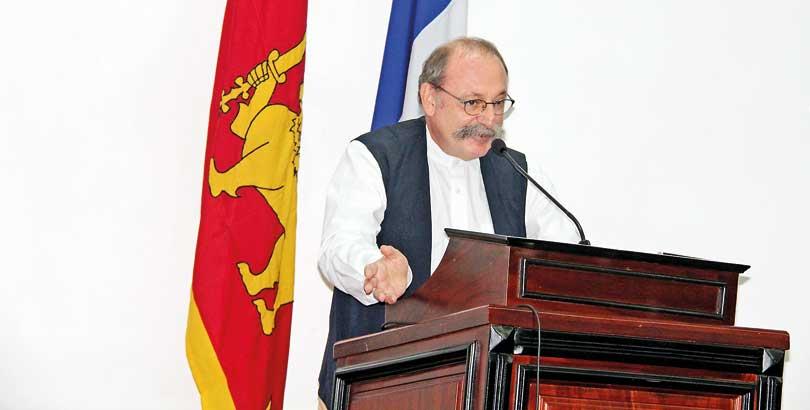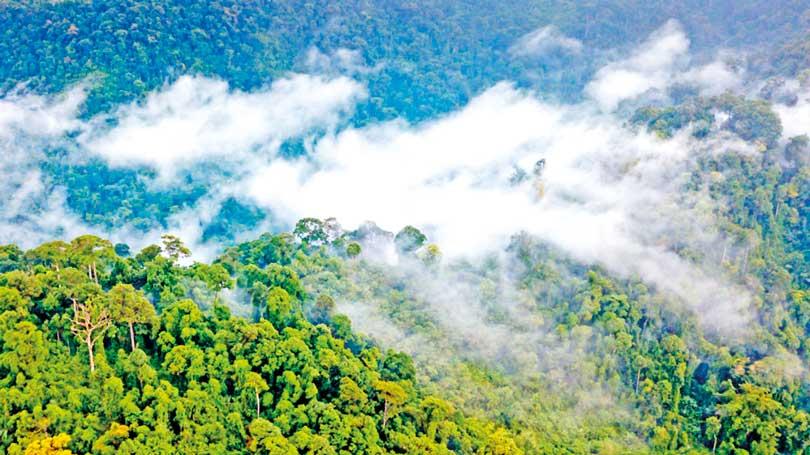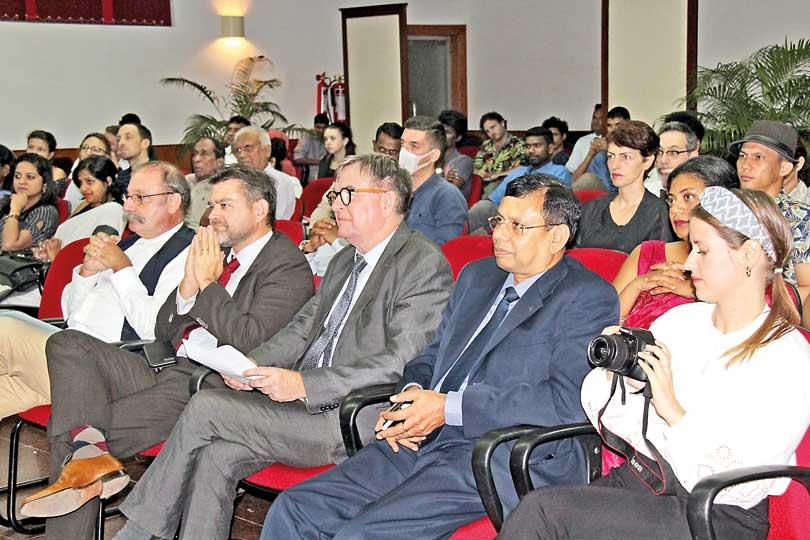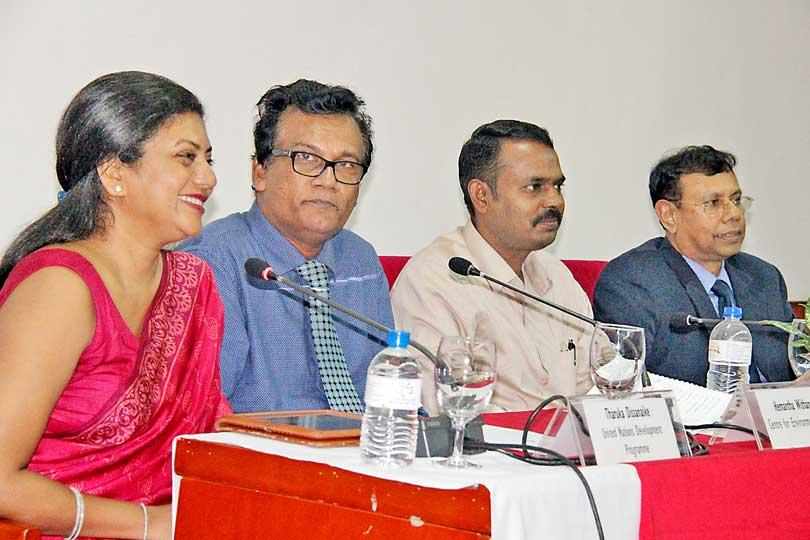Reply To:
Name - Reply Comment
It seems that, although Sri Lanka takes pride as a wise and moral nation, we often fail to appreciate how fortunate we are to be blessed with nature and its wonders.
 Last Thursday at the Bandaranaike Centre for International Studies (BCIS), the ‘Night of Ideas’ (in French: Nuit des Idées) featuring ‘Tropical Forests in Sri Lanka’ was organized by the French Embassy in Sri Lanka and the Maldives and the Alliance française de Kotte partnering with BCIS. The Night of ideas brought out so many innovative ways of thinking, ideas as well as global initiatives. That night, many environmental specialists shed light upon the subject of tropical forests, emphasizing on their theme of ‘Being Alive’.
Last Thursday at the Bandaranaike Centre for International Studies (BCIS), the ‘Night of Ideas’ (in French: Nuit des Idées) featuring ‘Tropical Forests in Sri Lanka’ was organized by the French Embassy in Sri Lanka and the Maldives and the Alliance française de Kotte partnering with BCIS. The Night of ideas brought out so many innovative ways of thinking, ideas as well as global initiatives. That night, many environmental specialists shed light upon the subject of tropical forests, emphasizing on their theme of ‘Being Alive’.
“From what we have seen in just the last few weeks from the forest fires in Australia, the environment has bounced back. It’s been extremely heart-warming to watch some of the photographs coming out of very badly burned areas and the trees themselves are coming back to life again. And this is the beauty of the environment, which we often forget.
My favourite French author Victor Hugo said that when a man is out of sight, he is very often out of mind. Now, this is what happens sometimes with the environment. We are not in tandem with the environment. We tend to forget that we coexist in a much larger ecosystem and it is not something that is constricted to the concrete cities in which we dwell in most instances.” Deputy Director at BCIS George I.H. Cooke said.

“You are privileged to have tropical forests in Sri Lanka. Certainly, you have the wisdom to protect them,” Ambassador of France to Sri Lanka Eric Lavertu said addressing the audience who gathered at BCIS on the “Night of Ideas”.
We are not in tandem with the environment. We tend to forget that we coexist in a much larger ecosystem and it is not something that is constricted to the concrete cities in which we dwell in most instances - I.H. Cooke
That night, the audience embarked on a journey into tropical forests where billions of plants and billions of animals were blending as one giant, sowing the seeds of our future. Tropical forests, according to the ‘Once Upon a Forest’ documentary which was screened that night, consists of a network, a wonderfully interconnected community that depends on each being for survival.
Featuring some spectacular macro-lens photography, soaring aerial shots captured by camera-laden drones, and delicate illustrative animation, French documentary ‘Once Upon a Forest’ offered an exquisite and richly informative enthralling lesson about rainforest flora and fauna. With their ability to work synergistically with ants and fungi, to send messages to one another about invading elephants, and to scatter their seeds across vast distances, these plants seem extremely intelligent for living entities which lack a nervous system.
Moreover, there’s the idea of anti-deforestation, an eco-message attached to the documentary, but even that’s delivered with minimal guilt-tripping. All of its spectators are left with a strong need to protect these forests after witnessing such beauty on the face of this Earth.
According to one of the guest speakers of the evening, N. Ayyappan from the French Institute of Pondicherry, Forests cover about 10% of the land surface sustaining almost 50% of the land’s life forms. From the air we breathe to the fertile soil we are privileged with, all of these are sustained and maintained optimally by these forest ecosystems.
International Union for Conservation of Nature Director Ananda Mallawatantri emphasized that we gain many benefits from forests. Other than their contribution towards the tourism industry, pharmaceutical industry and recreational uses, forests perform many environmental services such as pollination, water conservation, air purification, etc. “But do we put the right effort back to continue these benefits?” he questioned.
We don’t know how many species are there in tropical forests. Every country has recorded all discovered species but still, we don’t know exact numbers - N. Ayyappan
Besides, forests are important for environmental science and its sustenance. Forests are very rich in biodiversity and conservation of biodiversity is a must to maintain the intricate balance of the environment.
“We don’t know how many species are there in tropical forests. Every country has recorded all discovered species but still, we don’t know exact numbers,” Ayyappan said.
Threats towards tropical forests and biodiversity have increased exponentially. Ayyappan explained that droughts, forest fires, extreme disasters such as cyclones, floods and landslides were more frequent these days and all these issues pose a threat for the survival of forests. Furthermore, he said biodiversity is further threatened by the introduction of invasive species.
“Industrialization and urbanization make these forests more vulnerable. Almost half of the tropical forests have been disappeared due to human activities,” Ayyappan added.
IUCN Director Mallawatantri in his expert opinion believes agricultural expansion and infrastructure development to be the direct drivers of deforestation. Meanwhile, he believes that the government, economic growth and technological factors are potential indirect drivers.
We have an ongoing court case for the last five years against the destruction of Wilpattu. It seems that for just for resettlement, 3000 hectares or more land from Wilputtu Reserve was going to be destroyed - Hemantha Withanage
Hemantha Withanage from Centre for Environmental Justice explained how there were no more corridors in between forests in Sri Lanka due to building of human settlements in the middle of these corridors. Accordingly, he said that within the last 2 years, about 250 settlements were built by the government in Sri Lanka and out of them about 150 are in the elephant corridors. This is truly a tragic situation.
“Can’t we do all these without disturbing our forests? Can’t we have different building designs, ensuring the conservation of our forests?” Mallawatantri commented.
Meanwhile, to emphasise the threat towards biodiversity, Withanage pointed out they were at war to protect the Wilpattu Natural Reserve, which is a landing site to migratory bird species-rich in biodiversity.
“We have an ongoing court case for the last five years against the destruction of Wilpattu. It seems that for just for resettlement, 3000 hectares or more land from Wilputtu Reserve was going to be destroyed. We are still waiting for the results of the court case,” he said.

“We are talking about the 8.7 million estimated species and 70% of them being already gone. We are talking about the 6th mass extinction because of the climate change right now,” Withanage informed.
The Intergovernmental Panel on Climate Change (IPCC) of the United Nations (UN) define Climate change as a change in the state of the climate that can be identified (e.g. using statistical tests) by changes in the mean and/or the variability of its properties and that persists for an extended period, typically decades or longer. Accordingly, it refers to any change in climate over time, whether due to natural variability or as a result of human activity.
In Withanage’s belief, it is a must for us to have a clear idea about climate change, not only for the development environmental science field but for much simpler things such as helping farmers when the rainfall is more delayed
than usual.
Colombo is flourishing. The income is going up. How much of this income is going back to replenish the ecosystem services that Colombo enjoys? - Annanda Mallawatantri
According to him, in the future, by 2050-2080 dry zone of our country would increase drastically due to rapid temperature increment. Therefore, he believes it is a must to take initiatives to protect our world and prevent the worsening of the climate change issue.
“We may survive a 1.5-degree increase in temp but the snails; they cannot even tolerate 0.1 degrees. Will they survive? They might not survive,” he commented.

Similarly, polar bears are adversely affected by the melting of ice caps due to global warming. Frog species which lay eggs in water collected at the leaf tip are in danger as water gets acidic due to acid rains. All organisms are directly affected by these issues. As we pride ourselves as organisms with the highest intelligence, we have to mitigate the situation, co-exist with the environment and conserve it.
Forests cover about 10% of the land surface sustaining almost 50% of the land’s life forms. From the air we breathe to the fertile soil we are privileged with, all of these are sustained and maintained optimally by these forest ecosystems.
We are in a dire situation and we need to define a strategy for the conservation of natural forests. Even right now, several steps are being implemented to address these issues such as awareness programmes, the introduction of policies, establishing laws and regulations, organizing international conventions and establishing institutions such as the Wildlife Department.
However, these initiatives are not sufficient to mediate this situation. We need to come up with new and innovative steps to face these issues.
“Colombo is flourishing. The income is going up. How much of this income is going back to replenish the ecosystem services that Colombo enjoys?” Mallawatantri questioned.

Withanage believes that we should cater to children and change their mindset, convince them of the importance of the environment to have a brighter future in terms of environmental conservation.
Also, he said they were re-building forests instead of just planting trees through forests such as Kanneliya and Sinharaja and emphasised that it was extremely advantageous.
Furthermore, he said they adapt religious beliefs with conservation programmes where they ordain forests, preventing common folk from harming those trees.
Actions taken during the past few years towards conservation of forests had not been futile. According to the statistics presented by Ayyappan, the deforestation rate in Sri Lanka from 1976 -2015 is as follows.
These statistics indicate the declining trend of deforestation which proves the effectiveness of the conservation measures taken during the past few years. Similarly, if we implement proper actions now, we would be able to gain positive results within the next few years.